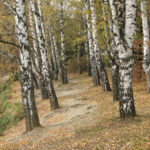When staining Pine, keep in mind it is a softwood like Birch, Fir and Maple. These woods have an uneven grain pattern. This may cause an uneven blotchy look to the finished project. To ensure a high quality finished piece of stained Pine or softwood, apply a conditioner to the wood before staining.
It is important to decide what type of stain will be used to finish the wood project. There are four types of stain. They are oil-based, oil-based gel, water-based and stain that is a combination of stain and polyurethane. All four have their advantages and disadvantages. Read the labels to make your decision. If you use the oil-based, oil-based gel or water-based stain, a polyurethane finish will need to be applied after the project is dry. The combination stain and polyurethane both stains and finishes with one coat.
Before a staining project begins, it is important to gather the required equipment to prevent extra trips to the store. To ensure an even stained finish, select an area that has good lighting and proper ventilation.
Supplies needed:
Drop cloth or newspaper (something to cover the floor)
Rags or paper towel (to wipe up spills and excess stain from project)
Sand paper (both medium (#120) and fine (#200) grit)
Tack cloth
Paintbrushes
Mineral spirits or water (used for clean-up)
Metal container
Screwdriver or paint can opener
Stir sticks
Rubber gloves (to prevent staining of the hands)
Safety glasses
Pre-conditioner (Make sure the pre-conditioner has the same base as the stain)
Stain
Step #1 – Sanding
Sanding is necessary on any wood surface before staining. Fill all cracks and holes with wood putty. Let dry before sanding begins. Decide how smooth you want the sanded surface. The rougher the surface the deeper the saturation will be of the stain.
Use a medium grade sandpaper (#120) to begin. Always sand in the direction of the grain to prevent scratches that can be seen after the staining is complete. Sand entire surface until it is uniformly smooth. Sand again with fine grade sandpaper (#220) until entire surface is smooth.
Remove all sanding dust before staining. A tack cloth is recommended but a damp rag is also sufficient. Dampen your rag with the same base as your stain. Mineral spirits for oil-based and water for water-based.
Step #2 – Conditioning the Wood
It is very important to condition Pine for a professional looking finish. The conditioner helps to eliminate the grain from rising and promotes a more uniform distribution of stain color. Again, make sure the conditioner matches the base of the stain. Let dry for the recommended time as shown on the conditioner’s label.
Step #3 – Staining the Wood
Stir the stain prior to application. Test a hidden or scrap piece of pine ( or the same type of wood) to be sure the color of stain is correct. Once this has been decided, begin staining the wood. Either use a brush or rag to apply the stain. Always apply the stain in the direction of the grain. After all the stain has been applied, give a final stroke to evenly distribute the stain and not leave any puddles. Leave stain on the wood until the desired saturation occurs. Wipe off any excess. Be careful not to let the stain dry at this stage or it will prevent the finish from adhering.
Remember, the harder you push with the rag when wiping of the excess, the more stain will be remove. If too much is removed, don’t worry, more may be applied. It is important to wipe off the stain and not allow any excess to remain to ensure the finish coat will adhere to the project. If a deeper or richer stain color is desired, repeat the staining process approximately every 4 to 6 hours. Let the project dry completely before applying the finish. This will take a few hours to a few days depending on the base of the stain and the humidity of the air. Water based stains dry quicker than oil based.
Note – Rubber gloves may be used while staining to avoid staining hands.
Step #4 – Applying the Finish Sealer
After the stained Pine project is completed, apply the correct finish sealer. A polyurethane based finish should be used if the stain was oil-based. A water based finish should be used if the stain was water-based. Stir the conditioner prior to application. Apply up to three coats of finish until the desired luster is achieved. Sand with a fine grit (#220) between coats. Make sure to wipe off the wood project before applying the next coat of finish sealer. Follow the instructions on the label for drying time in-between coats.
Note – If a one-step finishing stain is used, combine Step #3 and Step #4. The stain/finish combination eliminates one step.
Step #5 – Clean-up
Throw away all rags, newspaper, and paper towels used. These items may catch fire if not properly disposed. Depending on the base of the stain, use either mineral spirits or water to clean the brushes and other items that were used to stain.
Note – Point the bristles down on the brush while cleaning. This allows the stain to drip off rather than settle in the barrel of the brush.
Step #6 –
Enjoy the finished project!
A stained Pine project can look as elegant as any expensive wood if the proper processes are followed.
Product Information
All products may be purchased at your local hardware store. In the mid-West, the main stores are Menards, Lowes, and Ace Hardware. Stains run in price from $3.84 to $35.00 depending on the size can that is needed. Foam stain and spray on stain may be purchased also. Wood filler sells for a price between $2.49 and $8.98 per container. Sandpaper is sold in single or multiple grit packages. Prices vary based on vendor. Wood finish or sealer runs in the price range of $4.16 up to $37.00 depending on the size of can needed for the project.





